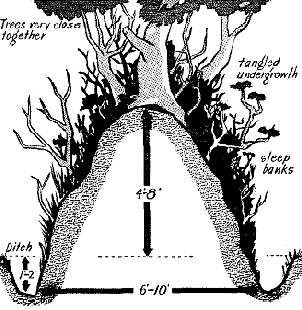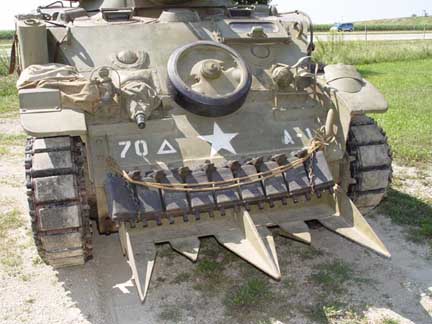Shortly after the American's and Brits landed in Normandy they found themselves caught up in a region known as the Bocage. In the Bocage, there are many, close together hedgerows - and contrary to my naïve understanding, a hedge row is not simply an overgrown piece of greenery, but it is a stone and dirt rampart which is then topped with trees and hedges.

The problem for the Allies was that going over the hedgerows made the tanks vulnerable, as their lightly protected underbellies were laid bare, and if they dynamited the problem the Germans who were well dug in would know through which part of the wall the allies were about to enter, and concentrate their fire accordingly. To pass one mile the allies might have to cross as many as three dozen hedge rows.

Things were becoming desperate because the armies needed to break out of this North East part of France, or risk being pushed back into the sea.
Along came one innovator named Sargent Curtis G. Culin who came up with the idea to attach a set of iron teeth to the front of the Sherman Tanks. These teeth, fabricated from the steel crosses that the Germans had set up on the beach to stop the landing craft, allowed the tanks to blast through the hedge rows - and surprise the enemy.
But, according to a speech by Dwight Eisenhower, many years after the war, Cullen's idea, had to make is way up the hierarchy. In a January 10, 1961 speech to the American Society of Mechanical Engineers Eisenhower said:
'There was a little sergeant. His name was Culin, and he had an idea. And his idea was that we could fasten knives, great big steel knives in front of these tanks, and as they came along they would cut off these banks right at ground level - they would go through on the level keel - would carry with themselves a little bit of camouflage for a while. And this idea was brought to the captain, to the major, to the colonel, and it got high enough that somebody did something about it -- and that was General Bradley -- and he did it very quickly"¦"
And the rest, as they say is history.

I think this story has a number of general lessons and questions. First the lessons
- Innovation -even when needed, often does not get support. Fortunately, the chain of command brought it to Bradley and he made it happen.
- Without innovation, the competition is often dug in and ready to stop you;
- There are always more roadblocks than you plan for - even if you have mapped the terrain as best you can - there are always surprises!
As a senior executive, you have to ask yourself:
- Are there Culins in my organization with innovations that can powerfully change the competitive landscape?
- Are they being heard?
- If they are not, am I as insightful as General Omar Bradley, and will I drive their ideas through my firm if needed?
What do you think? Are most organizations ready for a Culin?